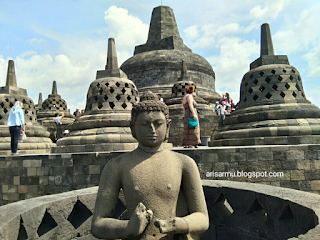While a holiday to Indonesia, visiting the world's greatest Buddist monument should be in your itinerary list.
The mighty Borobudur temple, constructed with 55,000 m3 andesite stones, sits on a hilltop in the southern part of Central Java which is in the most populated island in Indonesia, Java island. The place of Buddhist pilgrimage was discovered by British troops under Sir Thomas Stanford Raffles' leadership in 1814. This Mahayana Buddhist temple possesses 504 Buddha statues, including 72 are inside openwork stupas, with 2,672 ornament or relief panels was built between 8th and 9th century AD during the reign of the Syailendra dynasty and it's considered as one of the world's wonders since it can still stand upright without using any cement in its construction.
Borobudur has been listed as a UNESCO world heritage site. And Indonesian Buddhists still celebrate "Vesak" (Buddha day) at this temple once a year.
The universe in Buddhist cosmology
Buddhist cosmology states that the universe consists of three major zones, Kamadhatu, Rupadhatu and Arupadhatu. They represent the three stages of human life. The Borobudur monument illustrates those three stages.
The first section called "Kamadhatu", derived from a sanskrit word describes a world which is still full of desires and lusts. In this stage the soul is wandering from one body to the others as a process of a reincarnation in the circle of "Samsara" (rebirth).
The second section called "Rupadhatu".
In this stage humans have successfully controlled their desires and lusts and no longer abide in "Karma" (related with rebirth), but physically still exist in the real world.
The third section called "Arupadhatu".
This is the highest stage of Borobudur temple, symbol of the world which isn't abide in "Karma" nor in the physical existence. It is said as the holiness of Buddhist, the world of gods, where the real happiness exist.
The second section called "Rupadhatu".
In this stage humans have successfully controlled their desires and lusts and no longer abide in "Karma" (related with rebirth), but physically still exist in the real world.
The third section called "Arupadhatu".
This is the highest stage of Borobudur temple, symbol of the world which isn't abide in "Karma" nor in the physical existence. It is said as the holiness of Buddhist, the world of gods, where the real happiness exist.
Buddha Gautama
When you enter into the complex of Borobudur temple, you will see reliefs depict about Prince Siddhartha Gautama, who was the founder of Buddha.
He left his luxurious worldly life in the palace merely to search the meaning of life by fasting and meditating, so he went to a forest and started doing a meditate under a Bodhi tree. Then he was called as Buddha Gautama (The Omniscient or The Great).
His poses of meditating can be seen through the statues in Borobudur monument.
He taught his followers that Nirvana will be achieved by humans if they can get rid of their earthly desires, since life is believed as an eternal wheel of suffering.
Samudraraksa Ship Museum
After exploring Borobudur temple, you should head to Samudraraksa Ship Museum. It is still within the complex of the temple, you only need to walk for a few hundreds meters where you will see the collections about ship that made based by relief on Borobudur temple.
One day in 1982, there was an Englishman named Philip Beale who came to Borobudur to learn about the reliefs which adorn the temple.
The purpose of a-21 year old man, who worked for British Royal Navi, was to get more knowledge about traditional ships and marine traditions.
He was surprised to discover that one ship on Borobudur relief may have been a part of the famous spice trades in the past, for Indonesian Archipelago has been famed for its abundant of spices, such as cloves, cinnamons, ginger, as well as nutmegs, and the country has become a region for long distance trades.
Then he called Nick Burninghan to design the vessel of Borobudur and his friend ordered a Maduranese man, As'ad Abdullah, as the ship builder.
Then he called Nick Burninghan to design the vessel of Borobudur and his friend ordered a Maduranese man, As'ad Abdullah, as the ship builder.
Finally a replica of the vessel, which its dimention: 18,29 m - the length of the ship, 4,50 m of its width and 2,25 m of its body height could be constructed in Indonesia in 2003 and voyaged along the cinnamon route, Jakarta-Seychelles-Madagascar-Cape Town-Accra.
Presently, the ship is exhibited at Samudraraksa Ship Museum, and if you want to enter into Samudraraksa (it means The Guardian of The Ocean) you pay for IDR 100k (USD7.50).
Borobudur Museum
Visiting Borobudur Museum as a complement for you can see some artefacts related to Borobudur temple, some photos during its restoration as well as chemical substances used to maintain the temple.
First, you enter into the museum complex where you will face a pool with a fountain in the middle. Then, many sizes of andesite stones in the museum yard are a common sight.
There is also a statue of Buddha which the rumour was originally from inside of the Borobudur's biggest stupa.
Borobudur Temple
Location
Badrawati St, Borobudur, Magelang Regency, Central Java, Indonesia
(41 km from Yogyakarta City)
(41 km from Yogyakarta City)
Opening Hours
Daily 06.00 am - 05.00 pm
Entrance Fee
Local
Adult IDR 40k (USD 3)
Child (<10) IDR 20k (USD 1.50)
Tourist
Adult IDR 325k (USD 24.40)
Child IDR 195k (USD 14.65)
Student IDR 195k (USD 14.65)
Call Center : 024 8646 2345
Email : marketing @borobudurpark.co.id
Email : info @borobudurpark.co.id





